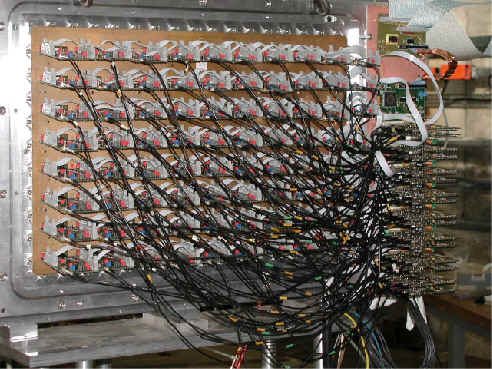

The
front-end electronics
The
readout of the HMPID modules is organized according to a parallel/serial
architecture and is based on the VLSI GASSIPLEX chip, specifically developed to
enable the determination of the hit coordinates by centroid measurement. It is
characterized by a filtering scheme designed to cope with the shape of the
signal delivered by MWPCs and by a long peaking time (1.2 ms)
suitable for an external event trigger. An average noise of 1000 e-
has been measured on detector.
The
16-channel preamplifier/shaper GASSIPLEX chips, uniformly distributed on the
back side of the cathode pad planes, are operated in analog multiplexed ‘Track
and Hold’ mode, storing the electric charge into internal capacitors in
coincidence with the arrival of a trigger signal.
Each
HMPID module is divided into two halves, in turn segmented into 24 rows of 10
daisy-chained 3-GASSIPLEX (3-G) cards. Each 3-G card performs a serial readout
of 48 pads at 10 MHz multiplexing frequency and the corresponding signals are
sequentially sent to a commercial 12-bit ADC (for analog-to-digital conversion)
and to the DILOGIC, an ASIC chip specifically
designed for zero-suppression. For Pb–Pb central events, an occupancy of 15%
has been estimated, corresponding to a total readout time of less than 200 ms.

The FEE cards: GASSIPLEX (left) and DILOGIC (right)

Proto-3 fully equipped with the final FEE